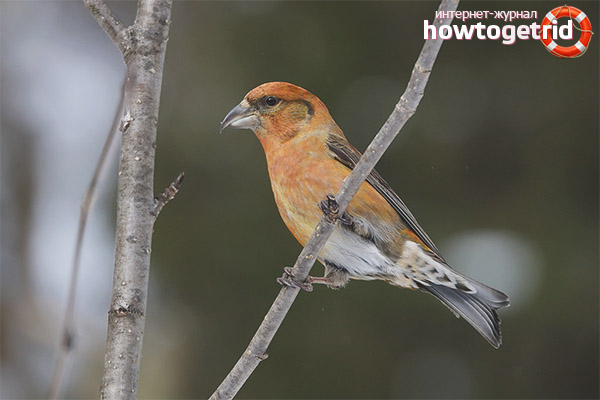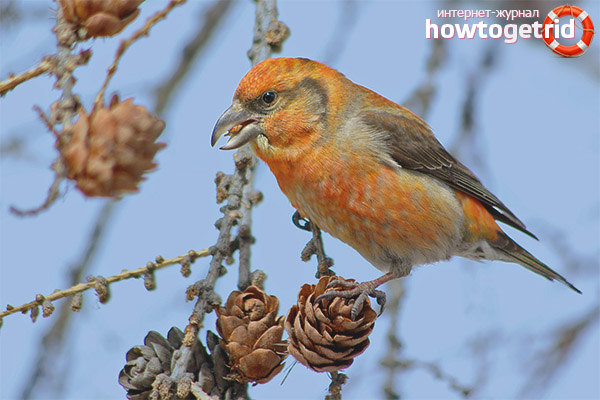The content of the article
A cross is a bird surrounded by legends and legends. It attracts the attention of a person with its interesting exclamation and external data. Recently, a popular trend has been the maintenance of these individuals at home. But in this case, it is extremely important to prepare to provide the feathered pet with everything necessary.
Description
- When spring approaches its end or summer comes, all individuals of the feathered family become very fussy. They build homes for posterity, are engaged in its feeding and training. In all this hustle and bustle, crossbills were also noticed - small feathered creatures with a beautiful color of plumage. But their offspring fall in the winter, so the birds among all look measured.
- The individuals differ in modest overall dimensions; they are red with a dark tint. The wings may differ from the body in hue. The birds are very calm, they do not panic, they move from one spruce to another in search of food. Poking cones and grains are pulled out of them.
- This bird stands out among others. The individuals have an interesting beak structure, the upper part is intertwined with the lower one, like crossing. The beak is round, strong. When an individual goes in search of food, it can easily break the cones of spruce, break through the bark or branches.
- In terms of overall features, the birds grow to about 20 cm. They are dense, knocked down the hull. Not only the beak of an interesting shape is striking, but also the double tail.
- Experts and lovers of birds have many theories regarding the true structure of the beak of these birds. Some believe that when Christ was crucified, birds crowded around the body and tried to pull out the nails. Since they are small in their dimensional characteristics, respectively, it did not work out. The beak is forever damaged.
- These feathered creatures have strong clawed legs. Birds move with great speed through the trees, and without the help of wings. They grab onto the branches, hang upside down, and then reach the desired cone.
- By the color of the plumage, the females are slightly different from males. The male’s chest is pigmented with a raspberry-colored hue, while in females this area is colored gray-green. But the plumage tone on the wings and tail is brownish.
- It has already been mentioned that bird singing is different from all other voices. Individuals of the family under discussion are laryngeal, loud, whistling mixed with twitter. Usually these sounds are clearly audible when the flight begins. At other times of the year, feathered ones are silent, only occasionally give voice.
- The external data of these birds are combined with other individuals that live on pine trees. By way of life, the birds are active during the day. When individuals engage in flights, they stray into talkative flocks and endlessly talk.
Lifestyle and habitat
- Birds require special food, they sit down on spruce and get seeds from cones. In view of this feature, birds fly from one place to another. Partly for this reason, crossbills are called migratory individuals. All year they roam, with all this there is no specific area of habitat.
- In some cases, you can find birds that gather in one place and cute coo. Then the flock breaks up, individuals fly apart at different edges. The whips are unique in nature. Either they crowd, or scatter, and the next year they don’t stay in the same place.
- The main source of food for these birds is conifer. Partly for this reason, individuals prefer to settle in the northern hemisphere, in the area where there are most coniferous forests.May also be present in the mixed band, but cedar is treated negatively.
- Housing for future offspring is built on top of trees, whether it be pine or spruce. They try to settle down where there are more branches, so that rain or snow does not penetrate into this place. Birds begin building nests when the first cold weather sets in.
- Birds build warm homes with dense bedding and sturdy walls. Crossbills rarely descend to the ground, they like to be on top. They also get food, relax, have fun, raise offspring.
- Some people prefer to keep such birds at home. In this case, it is important to take care of a strong cage with iron rods. Because the beak of individuals is strong enough, allowing a feathered friend to get out of an enclosed space.
- These birds are friendly, in the natural environment they have no enemies. A similar circumstance is associated with habitats, as well as feeding individuals. Since the main source of food is seeds, birds do not claim to be anything else.
- Due to the fact that due to the special diet in the animal’s body, a decent amount of tar and oils accumulate over time, after the death of the bird they become mummies. They do not decompose, like other individuals.
Breeding
- It is worth noting that the adults in question do not adhere to any specific period for reproduction. The couple begins to build a nest. After that, they warm it with lichen and moss. The female lays up to 5 eggs. They have a bluish color.
- After that, the female hatches the future offspring for a crescent. After the helpless young growth is born, the mother still remains in the nest. This happens until the plumage forms in the chicks. All this time, the male protects his family and constantly brings food.
- An interesting fact is that the individuals under consideration are the only representatives of birds that are not afraid to breed in severe frosty days. This happens for one very important reason. At this time, ripening of coniferous cones begins in the forests.
- After the birth of the chicks, their parents continue to feed them for another 2 months. This is necessary so that in the allotted time, the young beak grows stronger and becomes exactly as strong as that of adults. After this, the chicks can already independently split the cones. Young growth gradually gets used to independent life.
- Among other things, young juveniles can be distinguished from adult individuals without any problems. The characteristic distinguishing features are not only the beak, but also the color of the plumage. In young animals, you can see that it is grayish with spots. A similar color in adults is not observed.
Nutrition
- The main product in the diet of the considered individuals are spruce cones. Due to the peculiar shape of the beak, these birds remove flakes from the cones without any problems. Next, the seeds peck out the seeds. It is worth noting that literally a couple of grains is enough for her to eat birds.
- Feathered birds are disposed of immediately. Chipped cones pick up proteins, it is much easier for them to get goodies. As a result, small rodents find use for discarded cones. The same seeds are enjoyed with great pleasure by other inhabitants of the forest.
In today's article, we examined everything that affects feathered representatives. Where they are distributed, what they feed on, how they breed.
Video: Crossbill (Loxia curvirostra)












Submit